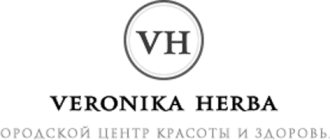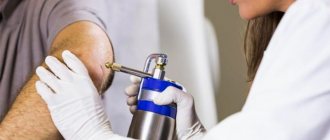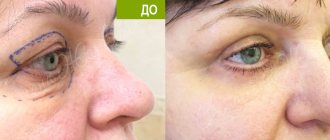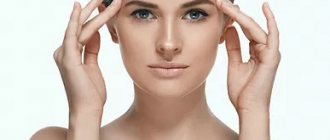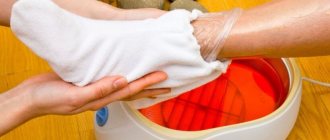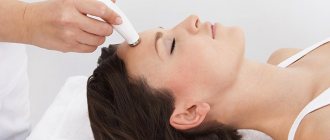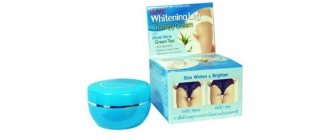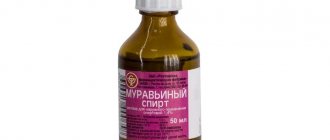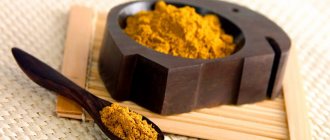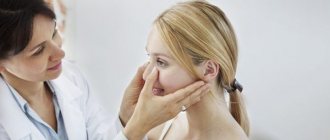Cryomassage has gained immense popularity among the fair sex. This is due to the high efficiency, safety and accessibility of this method. The essence of the procedure is to combine the effects of cold on the skin in combination with massage techniques. This method of rejuvenation and healing allows you to solve several skin problems at once.
How it works?
Cryomassage is performed not only for the purpose of rejuvenation, but also for overall skin health. During the manipulation, liquid nitrogen is used. This substance, when used correctly, has an anti-inflammatory effect, so during a course of procedures, problems such as acne and acne can be solved. The healing and rejuvenating effect is achieved due to a sharp temperature change combined with a light massage. This trains the vessels of the face, which improves metabolic processes, significantly increases blood circulation, and ensures the delivery of nutrients and beneficial microelements deep into the cells of the dermis.
Combination with other procedures
As we have already written, cryotherapy can be carried out as an independent procedure (in addition to the cryomassage itself, it also includes preliminary cleansing of the skin with milk and final care). However, greater results can be achieved by combining it with other facial care programs.
At the EFI Beauty House, cryotherapy is already included in skin cleansing procedures, anti-aging treatments (for example, Secret Age) and multifaceted programs: Satin Skin, Festive Face. In addition, a cosmetologist can create an individual procedure, including cryotherapy. Moreover, this can be either express care (for example, cryo + mask + massage) or a more intense program.
Main advantages
Many years ago, the benefits of rubbing your face with ice cubes in the morning were proven. In cryomassage, liquid nitrogen is used to achieve the same effect. This substance acts on the deep layers of the skin, helping to preserve the results for a long time.
Cryomassage of the face is performed in many cosmetology clinics. The prevalence and accessibility of the technique is due to high consumer demand. Most clients of beauty salons prefer this method. Compared to other rejuvenating procedures, the “cold” massage technique has its advantages:
- The technique is absolutely safe for the body;
- Cryomassage of the face can be combined with other cosmetic procedures - cosmetologists assure that this procedure enhances the effect of other skincare procedures;
- Despite the fact that a full course consists of 10-15 sessions, after the first procedure a positive effect can be noted;
- One manipulation has an extended effect: cleansing the skin, nourishing, moisturizing;
- A sharp drop in temperature has a positive effect on the condition of the skin;
- Cryomassage of the face does not cause painful or unpleasant sensations;
- This technique allows you to solve several facial skin problems at once.
Cryotherapy in a beauty salon: indications and contraindications
Cryotherapy will benefit all those who do not have compelling contraindications to this procedure, and will provide an excellent general strengthening and healing effect.
Cryotherapy in beauty salons and medical institutions is used for the following indications:
- obesity;
- cellulite;
- skin pathologies resistant to other treatment methods;
- gynecological and nervous diseases, ENT diseases;
- recovery in the postoperative period;
- treatment of injuries;
- combating chronic fatigue, depression, nervous exhaustion and sleep disturbances;
- age-related changes in the skin.
In beauty salons and dermatological centers, liquefied nitrogen is used to remove warts, moles, acne, scars, papillomas, and fight alopecia and seborrhea.
And this is not a complete list of indications for cryotherapy. It can be prescribed by the attending physician, who carefully monitors the course of the disease and the results of the procedures performed.
Main contraindications to cryotherapy:
- allergy to low temperatures;
- infectious diseases at any stage of their course;
- heart attack and ischemia of the heart muscle;
- stroke;
- hypertonic disease;
- pregnancy and breastfeeding;
- patient age under 16 and after 60 years.
Read material on the topic: Microcurrent facial therapy
Indications for the procedure
A course of cryomassage is recommended in the following cases:
- Spider veins on the face;
- Too dry, or, conversely, oily facial skin. Cryomassage normalizes the functioning of the sebaceous glands and eliminates these deficiencies;
- Skin diseases: eczema, dermatitis or even psoriasis;
- Loss of elasticity and skin tone;
- The appearance of wrinkles;
- Ptosis (sagging skin);
- Enlarged pores;
- Uneven skin tone;
- Acne, acne;
- Welts or scars on the face;
- Swelling of the face. "Bags" under the eyes.
Also, a cosmetologist may recommend a one-time cryomassage performed before other types of rejuvenating procedures, for example, before mesotherapy or biorevitalization. Sessions of the “cold” procedure are recommended to be carried out in the autumn or winter seasons, since after cryomassage the skin is very vulnerable to ultraviolet radiation.
Areas of application of cryotherapy
- Surgery: treatment of burns and incised wounds, erysipelas, bedsores and ulcers.
- Neurology: therapy of migraines, spastic hemiparesis, paraparesis, acute vertebrogenic pain syndrome, multiple sclerosis.
- Traumatology, orthopedics: therapy of tendons, ligaments, contractures, pathologies of soft and bone tissues, joints.
- Rheumatology: treatment of arthrosis, rheumatism, arthritis.
- Cosmetology, dermatology: treatment of skin diseases, scars, pigmentation, etc.
Due to its effectiveness (increasing elasticity and skin tone), cryotherapy remains the most popular procedure in cosmetology.
Possible contraindications
Despite the wide range of indications and benefits, there are several limitations under which cryomassage is not performed. These include:
- Diseases of blood vessels and heart;
- High blood pressure;
- Increased body temperature;
- Presence of abrasions and wounds on the face;
- Inflammatory and pustular formations on the skin;
- The period of bearing a child;
- Colds;
- Herpes on the face;
- Malignant neoplasms in the body;
- Allergic reaction to cold.
Hardware air cryotherapy (VAC) at GUTA CLINIC
VCT in our clinic is performed using the CryoJet S600 unit (Germany), which supplies any part of the body with an adjustable air stream, dried and cooled to a temperature of –60… –30 0C.
The use of CryoJet S600, a cryotherapeutic system of the latest generation, in local VCT provides the following therapeutic effects:
- inflammation is relieved;
- spasms and pain are eliminated;
- muscle tone is regulated;
- metabolism is activated;
- microcirculation is restored;
- cellular and humoral immunity is activated.
How is the procedure performed?
When performing this cosmetic procedure, the facial skin is cleaned of impurities and the surface of the skin is treated with liquid nitrogen. To do this, use a special wooden stick on which a cotton swab is wrapped. It is placed in a container with nitrogen and massaged over the entire face.
This manipulation can only be entrusted to a true professional. The specialist must carry out this procedure as carefully as possible, carefully avoiding the area under the eyes and near the lips. Depending on the purpose of the manipulation, its duration ranges from 10 to 20 minutes. Cryomassage involves a light massage with nitrogen; it is never rubbed into the skin. Some patients feel only a slight burning sensation from the feeling of cold. At the end of the cosmetic procedure, the face is covered with moisturizing cream. You are allowed to go outside after 30-40 minutes.
At the end of the cryomassage, slight redness of the skin may be observed. There is no need to be scared, this is the norm. Literally within a day, this symptom goes away on its own.
Types of cryotherapy in a beauty salon
- A separate type of cryotherapy is a procedure for eliminating acne. Liquid nitrogen is applied to the affected skin using a special wooden spatula and kept on the skin for a certain time.
- If there are formations on the skin that are more serious and persistent than acne, then cryodermabrasion is used to remove them. This procedure is characterized by exposure to ultra-low temperatures and removal of the upper layers of the epidermis.
- Warts are removed in beauty salons and dermatological clinics by cryodestruction. The essence of the procedure is that a small area of skin affected by warts is exposed to cold. The result is destruction of the treated integumentary tissue.
- Aerocryotherapy is a restorative procedure that involves blowing cold air onto the skin. It is usually prescribed after plastic surgery.
- Also in beauty salons, cryolipolysis is used - this is a procedure that removes deposits of adipose tissue.
Choosing the type of cryotherapy that is right for your skin is extremely difficult on your own. Before doing the procedure, be sure to consult with a specialist and diagnose the skin on your face. After this, the cosmetologist will tell you what type of cryotherapy in a beauty salon is best for you to use.
Recommendations after cryomassage
For 7 days after the procedure, it is recommended to avoid direct sunlight - it is for this reason that this manipulation is not recommended for summer. If you need to go outside, you need to wear a hat with a brim so that the skin of your face is in the shade. It is not recommended to use foundation during the week; you can only use moisturizers with SPF of at least 20.
Within 2-3 days after the procedure, slight peeling of the skin is possible; this is an absolutely normal reaction of the body to exposure to cold. After the specified time, all inconveniences disappear on their own.
Cryotherapy: cold treatment - main indications
MAIN INDICATIONS OF LOCAL CRYOTHERAPY:
1. Injuries As for injuries, several factors play a role here, differing depending on the type of pathology, orthopedic or surgical treatment performed. The decisive factor when choosing the type of cold air treatment is the type of injured tissue: it determines whether short, semi-moving therapy should be carried out on a fixed point, or longer therapy with wide, sweeping movements over the treated area. For each type of pathology, it should be taken into account that cryotherapy is divided into the following stages:
- Immobilization stage, if possible immediately after surgery, with bandaging with an elastic bandage, splints, plaster casts or the use of postoperative fixation devices;
- Stage of regeneration of joint range of motion and muscle activity;
- The stage corresponding to the resumption of sports or other normal activities.
Traumatic pathologies are divided into bone, joint and muscle pathologies; Fractures have general consequences that stem from immobilization. 1.1. Bone pathologies 1.1.1. Reduced risk to veins Since cold prevents blood stagnation and joint or muscle swelling after surgery, it also reduces post-operative risk to veins. Indeed, it is known that exposure to cold leads to vasoconstriction followed by vasodilation. 1.1.2. Muscle atrophy Following joint surgery, such as the knee, the most common complication is loss of mobility, often accompanied by an inflammatory response to surgery. The use of cold air allows the use of physiotherapy at an earlier stage to reduce inflammation and avoid muscle atrophy. 1.2. Joint pathologies 1.2.1. Sprains At the stage of immobilization, when the patient is not bedridden, when bandaging with an elastic bandage: When treating overstretch, cryotherapy can prevent the occurrence of pain and inflammation. During immobilization, the bandaged area is treated directly with the hose. During the immobilization stage, when the patient is not bedridden, when applying splints or plaster casts: The use of cryotherapy is limited to splint or plaster material. After removal of this material, post-traumatic swelling is often observed in the injured area, to which cryotherapy can be applied. In this case, cryotherapy will have an analgesic, trophic, and anti-edematous effect. The analgesic effect will increase when combined with low-frequency currents. 1.2.2. Dislocations In case of dislocations, cryotherapy is used for analgesic or trophic effects.
1.3. Damage to mouse, tendons . Tendopathy (tendon diseases) There is a disproportion between the forces acting on the tendon and the resistance of the tendon fibers. Tendopathy is usually accompanied by pain mechanisms rarely associated with inflammatory signals. The latter are only a belated manifestation of long-developing degeneration. There are several types of tendonopathy: - pathologies associated directly with the tendon (tenalgia); pathologies associated directly with the tendon, accompanied by inflammation (tendinitis); pathologies associated with the muscle-tendon junction or, more often, with the place of attachment of muscles on the bone (attachment tendinopathy). A distinction is also made between tendomyositis, tendoperiostitis, and tendoplasty. Finally, pathologies of the tendon appendages, tendobursitis or tenosynovitis are also possible. Some of these diseases can be treated with physical therapy (tendinitis, tendomyositis, tenosynovitis); For other diseases, physiotherapy is only relatively indicated, or even contraindicated. It is well known that the best way to overcome pain is to combine several methods of therapy. The tendon should be immobilized with adhesive tape or other non-elastic bandage. It is now possible to combine exposure to cold air and a closed bandage with analgesic or anti-inflammatory electrotherapy. 1.3.1. Periostitis Physiotherapy for periostitis usually focuses on progressive stretching of the painful muscles. Physiotherapy also includes cold air therapy in combination with iontophoresis of anti-inflammatory substances. Cold air therapy is carried out with wide movements along the leg at a distance of 5-10 cm for 2-3 minutes. 2. Rheumatology Cold air has better therapeutic qualities in the treatment of inflammation than other cold sources. With cryotherapy, the range of applications expands, since cryotherapy uses lower temperatures and has a longer lasting analgesic effect. Rheumatic diseases such as ankylosing (rheumatic) spondylitis or polyarthritis can be treated more effectively. Cold air also provides shorter, focused therapy to pain areas (trigger pain zones, acupuncture points). 2.1. Arthrosis Pain relief achieved with cold air allows joint mobilization to be less painful. The range of motion can be increased by blowing cold air onto the contracted muscles. Strengthening muscles with isometric contractions can be very painful; relief is achieved through pre-therapy with cold air. Edema or hydrarthrosis, which often accompanies this disease, is easier to treat. Due to the anatomical imbalance of the periarticular circulation, therapy should be carried out using a hose without a constrictor in order to avoid heating caused by blood supply from non-treated areas. The best treatment method is to use wide, sweeping movements over a large area. Since heat shock is important, cooling of one surface continues while the other surface is being treated. The results are longer lasting than with cold compresses. 2.2. Joint diseases For diseases such as tendinitis, bursitis or tenosynovitis, the main symptoms are inflammation, which is usually accompanied by swelling. Therapy is carried out using attachments of various sizes, depending on the size of the treated area. You can treat the leg first, then apply a bandage between therapy sessions. The quality of therapy is proven by a decrease in swelling. 2.3. Neurodystrophic pain Cryotherapy improves the resorption of edema and reduces capsular retraction. For neurodystrophic pain in the shoulder, cold air helps clear periarticular venous stagnation, leading to cystitis, and also reduces the inflammatory process. This facilitates manual mobilization. The faster release of cold air into the joints speeds up the healing process. Complete wrapping is difficult due to the presence of neurovegetative pathways. Cold compresses are impractical here due to the contours of the surface being treated, while cold air adapts perfectly to the type of surface being treated. For neurodystrophic pain, the use of cold air gives very interesting results. The method used is therapy with wide movements around the joint being treated, while the outlet of cold air is maintained at a distance of 5 - 10 cm from the surface of the skin, without stopping for more than 5 seconds in one place. Therapy lasts 2-3 minutes for the peripheral areas and at least 5 minutes for the shoulder where the muscle thickness is greater. During the entire therapy session, the condition of the skin should be monitored. In total, no more than 20 therapy sessions should be performed. The resulting effect can be explained by a decrease in CO2 and O2 pressure, which leads to an increase in vascularization (formation of new vessels) and a decrease in fibrin, histamine, and lactic acid. Others explain the effect produced by cryotherapy as a peripheral vasomotor effect, with a short initial constriction of the blood vessels followed by a prolonged dilation of the blood vessels. 2.4. Back pain Cold air reduces contracture and periarticular pain. The reaction produced by cooling with air at a temperature of -30°C increases blood circulation and promotes the effect of “bathing” the treated area. The therapist can now perform therapeutic procedures that will bring relief to the painful area. Cryotherapy has a positive effect on the muscles of both the dorsal and lumbar areas. For neuralgia of the lower or upper extremities, exposure to cold air reduces inflammation of the nerve roots and reduces pain. 2.5. Trigger pain A muscle strain is accompanied by spraying with ethyl chloride spray. Sometimes the best results are achieved by treating several trigger zones in a painful area, such as the shoulder. Combining both methods will deactivate trigger zones. The patient must be relaxed, then the muscle is subjected to progressive tension and slow, rhythmic exposure to cold air begins. The air flow should cover the entire muscle. The muscle must then be stretched. As range of motion increases, relaxation becomes progressive so that trigger zones remain deactivated. Travell gives precise instructions regarding evaporation (atomization). It is possible to use sprays of various qualities, but the main preference is given to working with cold air. Sprays are used up very quickly, which significantly increases the cost of therapy. Cold air is always available at a low cost. Moreover, different attachments will provide adaptability to different types of muscle therapy. The air outlet should be at a distance of 15 - 20 cm from the surface of the treated area; wide movements should be made very slowly, they should be repeated several times in order to achieve coverage of the entire muscle. This method of therapy will transmit a continuous flow to the brain level and create a certain barrier. Cold should be applied at an angle of 30° and follow the direction of the muscle fibers. 3. Neurology For neuralgic diseases, cold air can be used just as successfully as other cold sources, for example, with a disease such as painful musculofacial syndrome (positive results in 70% of cases, with the correct impact on the excitation zone). For central injuries with spasticity, sweeping movements with cold air for 5 to 10 minutes will lead to a decrease in hypertension. In case of hyperthermia of central origin (disorder of the autonomic nervous system), for example, with paralysis, the antipyretic effect of cold gives positive results. Wide movements with cold air can be successfully carried out over the groin folds.
Contraindications for cryotherapy
1. Vascular problems Arterial obliteration and venous thrombosis contribute to the development of chronic ischemia, which occurs due to a reduction in peripheral blood flow (oxygen starvation) and negative elimination of metabolic products. Local exposure to cold in such ischemic areas can exacerbate problems and lead to tissue death. Vasculitis (as seen in diabetes or Raynaud's disease) is also a contraindication to cold air therapy for the same reasons. 2. Increased sensitivity to cold Some patients exhibit an allergic reaction to cold, with local or general rash like urticaria and joint pain, or even collapse, intermittent hemoglobinuria, cryoglobinuria and purpura. Similar reactions may occur in patients suffering from lupus erythematosus, nodular periarthritis or scleroderma. In addition, such allergies can appear in elderly patients, children, weakened and exhausted patients. If there is any doubt, a small area test should be performed before any therapy.
Will cryomassage help with acne?
Some perform cosmetic procedures to improve skin health. Most patients wonder if cold application in combination with light massage can treat acne? Cosmetologists say that this is quite possible. Cryomassage increases blood flow, which helps kill bacteria that cause pimples or blackheads. After manipulation with liquid nitrogen, acne becomes covered with a crust, which disappears after a few days. Cryomassage sessions are also carried out to get rid of scars and acne marks (scars, post-acne).
Patient's condition after the procedure
Most patients experience no complications after cryodestruction; the manipulation is well tolerated by patients. Wound healing after cryodestruction occurs according to the type of aseptic exudative inflammation. This explains the fact that on the first day after surgery, body temperature may rise to subfebrile levels (37-37.2 degrees).
Pain in the throat may last 3-4 days. The maximum pain disappears within the first day. Every other day, a gray coating may appear, which disappears in 5-10 days.
If pain occurs at the site of exposure, the patient is usually prescribed painkillers, taking into account individual tolerance.
What effect should you expect?
If you complete a full course of cryomassage, you can achieve the following results:
- The skin of the face is cleansed of dead cells, the skin of the face becomes smooth and even;
- A healthy complexion and natural blush appear;
- The functioning of the sebaceous glands is normalized;
- The intensity of skin inflammatory processes decreases;
- Scars become less noticeable;
- Acne is eliminated;
- Expression wrinkles are noticeably smoothed out;
- The skin becomes elastic and elastic;
- The pores on the face narrow and become almost invisible.
Before the procedure, it is recommended to consult with a cosmetologist and make sure there are no contraindications.
What diseases does cryotherapy treat?
In addition to cosmetology, cryotherapy is also actively used in medicine: with the help of cold exposure, you can normalize blood circulation, improve metabolism and improve the health of the body as a whole, and increase immunity.
Cryotherapy can be prescribed for postoperative or post-traumatic rehabilitation, for the treatment of inflammatory diseases of the joints and bones, for diseases of the musculoskeletal system, skin diseases, and diseases of the respiratory system.
Cryotherapy for diseases of the ENT organs
Most often, cryotherapy is prescribed for chronic diseases of the respiratory system: rhinitis (especially allergic rhinitis), tonsillitis and pharyngitis, helping to relieve soreness and dryness, and stage 1-2 adenoids. Cryotherapy is also used in cases where traditional drug treatment does not produce effective results. In addition, cryotherapy activates the immune system, which is very important if you are prone to colds. With cryotherapy, blood microcirculation improves, regeneration of damaged tissue increases, and swelling is relieved.
The procedure is usually performed on an outpatient basis, under local anesthesia with lidocaine. Using a special device, the doctor applies liquid nitrogen to the pathological focus without affecting healthy tissue. In case of purulent discharge from the lacunae of the tonsils, treatment and rinsing with antiseptics is necessary before cryotherapy, after which you can begin the procedure itself.
Only an otolaryngologist can prescribe a cryotherapy procedure and only in the absence of contraindications, for example, pregnancy, acute respiratory viral infection, or furunculosis.
Azalia ShayakhmetovaDermatovenerologist, cosmetologist
Cryotherapy for skin diseases
Cryotherapy is especially effective in the treatment of skin diseases such as various dermatitis, psoriasis, acne and post-acne. Exposure to liquid nitrogen relieves rashes and irritation, reduces itching, and reduces the area of skin damage. By improving blood circulation and increasing immunity, skin cells regenerate faster and healing occurs faster. For extensive manifestations of the skin disease, a cryosauna is usually prescribed. If cold exposure is necessary on individual areas, for example when treating acne on the face, then liquid nitrogen is applied locally.
— A properly selected course of local cryotherapy significantly improves skin healing, increases tone, improves blood supply and skin nutrition. It is also very effective during post-traumatic and post-operative recovery,” says the dermatologist.
Cryotherapy for diseases of the musculoskeletal system
Cold is useful in the treatment of diseases and injuries of the musculoskeletal system, spine, for example, arthritis and osteochondrosis, as well as inflammatory processes in the joints, for example, arthrosis of the knee joint.
Cryotherapy is one of the most effective procedures in the treatment of bone and joint pathologies. It increases blood circulation, eliminates muscle spasms, improves the elasticity of muscles and ligaments, reduces inflammation and has a powerful analgesic effect.
Azalia ShayakhmetovaDermatovenerologist, cosmetologist
In modern physiotherapy, various technologies for performing cold procedures are used: synthetic cryonics, massage with ice cubes, ice applications, cold bandages and bandages, local baths and cryogenic installations, etc. The procedure has few contraindications: Raynaud's disease, peripheral circulatory disorders, individual intolerance to cold and general contraindications to physiotherapy.
conclusions
General cryotherapy is a promising physiotherapeutic method for the treatment of various diseases (cardiovascular, pulmonary, skin, musculoskeletal, endocrine, reproductive and other systems) and general improvement of the body with proven effectiveness. Its popularity among patients and specialists continues to grow, as interest in preventive (preventative) and adaptive medicine increases every year. At the same time, cryotherapy devices are being improved: they are becoming more compact and controllable, and the effect of cold on the patient is becoming more powerful and safe.
The medical market offers various devices for general cryotherapy: cryocapsules, cryobarrels, cryosaunas. All of these types of equipment can be used for cold therapy. At the same time, the fastest, brightest and long-term therapeutic effect without the risk of hypoxia and frostbite is provided by the latest generation device - the ICEQUEEN cryocapsule. Today, this is the only cryosystem that maintains a stable low-temperature regime within the range of -130 - -160°C throughout the entire volume of the chamber, covers the maximum area of the body with cold (98%) and eliminates hypothermia of the bronchi and lungs, since the patient breathes through the window during the session - porthole
Temperature regulation systems of the human body and cryotherapy effectors
1. The human body and cold The body adapts better to heat than to cold. However, it does have mechanisms to combat the effects of cold. During exposure to cold, vasoconstriction occurs in the body: this removes blood from the skin, since the aggressiveness of the cold acts externally. This way the body retains heat and maintains a constant internal temperature. This change in blood flow occurs partly due to the indirect effect of cold on the skin vessels, partly due to the central regulation of temperature (thermoregulation), which changes the sensory tone of the skin blood vessels. As the temperature decreases, the sensitivity of the tone increases, and the blood vessels narrow. 2. Thermoregulation Thermoregulation ensures that the core body temperature is maintained at a relatively constant level during rest or work. A similar regulatory mechanism operates in all the main elements described below. 2.1. Temperature Receptors These central or peripheral receptors respond to heat or cold. They are connected to the cerebral cortex, as well as to regulatory centers located in the hypothalamic center, through nerve fibers. Receptors of the hypothalamic center respond to minimal temperature deviations (0.1 to 0.2 °C) in the flow of arterial blood. 2.2. Temperature effectors Temperature effectors respond to stimulation coming from receptors and produce regulatory changes. These temperature effectors are skeletal muscles, skin arterioles, sweat glands, and some endocrine glands. 2.3. Hypothalamic center The hypothalamic center is located in the hypothalamus and coordinates information received from receptors with the regulatory action of effector organs. The sensitivity threshold for temperature changes is very low (between 0.1 - 0.2°C).
Physiological reactions to a decrease in skin temperature depend on the frequency, time of exposure, and the magnitude of the temperature decrease. 1. Vasomotor (vasoconstrictor) effects Local exposure to cold causes a noticeable vasoconstriction due to dual local and reflex action. It is often used, for example, to prevent post-traumatic bleeding. If the exposure is prolonged, the reaction is hyperemia, as a protective mechanism of the tissues. However, the same reaction appears along with the breakdown of proteins or the precipitation of cryoglobulin when there is a significant temperature difference (a decrease in skin temperature by 10 -15 ° C). In this case, the advantage of cryotherapy becomes noticeable, since the supplied cold air at a temperature of -30°C is able to lower the skin temperature by more than 20°C, but at the same time it causes only a weak reactive hyperemia due to the short duration of the effect, as is customary with cryotherapy . Vasoconstriction also helps reduce swelling, and therefore inflammatory reactions. At the same time, the physiological mechanisms of tissues are weakened; for example, cellular activity decreases (skin tissue, synovial tissue, leukocytes, etc.). Also, among other things, enzymatic and proteolytic (protein-breaking) activity decreases. By reducing metabolism, exposure to cold leads to a decrease in inflammatory activity, minimizing the negative effects of oxygen starvation of tissues (for example, with burns). However, this effect should not be long-term, since the same mechanism will then lead to inhibition of tissue healing. 2. Sensory-motor effect A decrease in skin temperature when exposed to cold leads to a decrease in nerve conduction velocity (it freezes at a temperature of about 5°C). Unmyelinated and small-diameter myelinated fibers are affected first. The analgesic effect of cold, as well as a decrease in conduction velocity in the fibers, occurs there before the motor neurons are exposed. 3. Effect on tone Cold affects many components of the sensory-motor complex associated with muscle tone, causing, for example, a decrease in nerve conduction velocity, a decrease in the excitability of the neuromuscular spindle and tendon bodies (manifested with a minimum decrease in temperature to 32 ° C ), as well as a decrease in neuromuscular transmission or even its freezing (at a temperature of about 5°C). In addition, an increase in muscle fibers and joint elements, viscosity leads to a decrease in muscle tone. This increase affects reflex reactions by changing the relaxation time of muscle fibers. A decrease in muscle tone is achieved in part by suppressing the muscle feeling reflex, which can be used in the treatment of spasticity.
